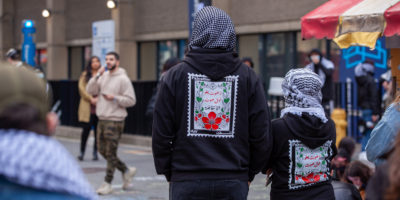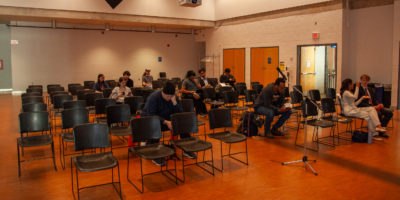By Rhea Singh
With the COVID-19 pandemic creating restrictions for on-campus events, Ryerson’s Pow Wow and Education Week 2020 has transitioned to a virtual setting this year. Including a week of videos, workshops and panels streaming online from Sept. 20 to 25, the Virtual Pow Wow will stream on Sept. 25 at noon, featuring dancers, drum circles and vendors in a digital space.
Jessica Sherk, chair and education week lead of RU Pow Wow and Anishinaabe woman from Tkaronto, said it has been a learning curve when planning the event and its virtual setting during a pandemic.
“In the early stage of our planning, we were monitoring the daily and weekly updates from the government, public health authorities and the university’s response to try to plan accordingly,” said Sherk.
According to Sherk, possibilities for what the event would be like was brainstormed for a considerable amount of time, from an in-person Pow Wow to digital to a hybrid event. The event is pre-recorded by Indigenous filmmakers Moontime Productions, also featuring RU Pow Wow’s head dancer, drummers, MCs and videos submitted by the community.
“As safe as possible, we wanted to recreate the sense of community and interaction experienced at Ryerson’s previous in-person Pow Wows,” said Sherk.
The online experience is inspired by digital events such as Cyber Pow Wow, an online Pow Wow that took place between 1997 and 2004 online, and social distancing Pow Wows that have taken place on Facebook. Sherk said that Ryerson’s Pow Wow has reimagined its programming as well and they spoke with lead organizers of the Stanford Pow Wow to learn more about their transition from real world to the virtual.
“Indigenous peoples have been gathering in different ways since time immemorial, but Pow Wows are more contemporary events inspired by Western rodeos and the traditions of Indigenous Plains groups,” said Sherk. “Pushing the boundaries of colonial institutions with Indigenous-led events like Pow Wows is very important.”
While the virtual setting can feel like a way to expand the event to people outside the Ryerson community, it also comes with a loss of community connection.
Denise Mcleod, one of the hosts for this year’s event, spoke about the importance of community, coming together and how ingrained it is within Pow Wows.
“I’m still here, my family is still, we are still authentically Indigenous”
“For me, it’s been something I didn’t realize I loved so much,” said Mcleod. “I knew they were important to my community and I knew that they were important to my family, but I didn’t realize how integral a part of my knowing, being and living they were.”
Both MCs this year are breaking the conventional stereotype of the role that is traditionally male dominated.
“Historically, MCs have been a male job, there’s been a growing community of women MCs. I love to challenge historical roles and guidelines,” said Mcleod.
Mcleod, who is also the Indigenous student coordinator for the midwife education program at Ryerson, said while the virtual setting is great, it won’t be the same as going to the Pow Wow grounds.
“I miss the sense of community and [feeling of] ‘this is where I belong,’ because this is what my ancestors have done for a very long time,” said Mcleod. “For many of us, because of displacement, because of residential schools, we didn’t grow up experiencing culture from a small age.”
For Mcleod, it’s the sensory experience, from the food wafting, to the medicines burning. She said that you can’t have the full experience of all your senses being heightened virtually.
“Walking around, talking to the vendors, getting your scon dog or tacos and lemonade, and wandering around with your friends and running into people you know,” said Mcleod “It’s not going to be that community sense that we had but it’s still community-built in that we are still trying to maintain cultural practices.”
However, even with the limitation of the virtual setting, continuing to have Pow Wows is incredibly important and that community members will be able to deal with the distance due to the constant change that Indigenous communities have been subjected to historically.
“Virtual Pow Wows are going to look a lot different than regular Pow Wows,” said Mcleod. “What the beauty is about this is that Indigenous folks are evolving and for a longer time than not, since colonization, we’ve had to hide our ceremonies and celebrations. We’ve adapted to the fact that we can’t be together anymore and very quickly.”
While the community has changed over time, so has the format of the Pow Wow.
“The format evolved and grew widespread across Turtle Island and Pow Wows became occasions for nations, families and friends to gather, dance, share news, food, celebrate and trade,” said Sherk. “You can expect different types of drumming and dancing, including Jingle Dress, Fancy Shawl, Traditional, Grass. The drums are unique to each drummer and drum group.”
Even with the loss of in-person Pow Wows, Mcleod remains hopeful about the virtual setting.
“Virtual Pow Wows are creating an accessible space for folks,” said Mcleod. “People still are dancing to the drum, people still are wearing their regalia, people still are using the language and singing the song.”
Mcleod also mentioned the Pow Wow’s healing significance, saying that many people could benefit from the dances that are specifically about healing.
For Randi Lynn Candline, a jingle dress dancer, healing comes from not just the community but the noises her jingle dress makes when she dances.
“We’ve had to fight to maintain and relearn our culture and our languages”
“The reason why our dresses make noise is because the noise they produce has the ability to cleanse the air of negative energy and from that aspect people also refer to the jingle dress as a healing dress,” said Candline.
In the video which she submitted for the virtual Pow Wow, Candline wears a pink dress adorned with jingle cones. Jingle dress cones often get mistaken for bells, Candline said, but are metal rolled up into cone shapes. The sound they make from hitting each other also mimics the sound of rain falling.
“There are many different styles of jingle dresses. My dress in particular is an apron dress; there are two layers with a skirt underneath.” said Candline. “It’s an older style dress that is starting to come back in fashion,”
Candline’s own mother, grandmother, uncles and aunts are all survivors of residential schools, with a long history of residential schools in her family.
“We’ve had to fight to maintain and relearn our culture and our languages, so the Pow Wows have been a really amazing bridge. The outfits we wear, the colours we wear; there’s so much history behind it and so many teachings, it’s a lot more than what you see on the surface,” said Candline.
But for Candline, it’s more than just a sense of community or teaching others about the importance of Pow Wows. It’s also about her nieces and nephews and creating a stage without insecurities and fears when it comes to dancing. Growing up, Candline was shy, but her dancing made her feel confident and connected to something bigger than herself, something she hopes for her nieces and nephews.
Candline talked about how she makes outfits for her nieces and nephews, and she doesn’t want them to feel the loneliness she felt being the only dancer in her family.
”Then I remember it’s okay that I didn’t come from a Pow Wow family because I’m starting my own,” said Candline. “When I see my nieces and nephews dance I think of how hard I worked to be a dancer and how hard I had to work my own personal identity and confidence, and to see them go out there and have fun with none of the insecurities that I had is good, because they didn’t have to fight the way I had to fight.”
The connection of culture with Candline is something she says she can feel when dancing at Pow Wows, but she mentions that for outsiders who don’t know the history of Pow Wows or are new to Canada, these events are bridges to learn more.
“It helps to portray a very positive light of indigenous people, while in mainstream media it’s very negative and focuses on trauma, criminal offences, drug use and poverty,” said Candline. “Pow Wows are a great opportunity to see us thriving in a healthy setting and enjoying community and welcoming people.”
Mcleod also feels that Pow Wows can help create a new narrative of Indigenous people in North America.
“I think it’s important to know that we are still here. When people talk about Indigenous peoples in North America it’s done in this historic way, that all these traumatic things that have happened to us are historical,” said Mcleod. “Often the narrative of Indigenous peoples is that we are of something a long time ago, and we aren’t modern, or that we don’t even exist anymore.”
As someone who has relations with Ryerson, Mcleod said walking on campus and seeing the statue makes her realize one thing:
“I’m still here, my family is still, we are still authentically Indigenous.”
The virtual Pow Wow will be streamed on Sept. 25, at 12 p.m. at rupowwow.com










Leave a Reply